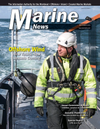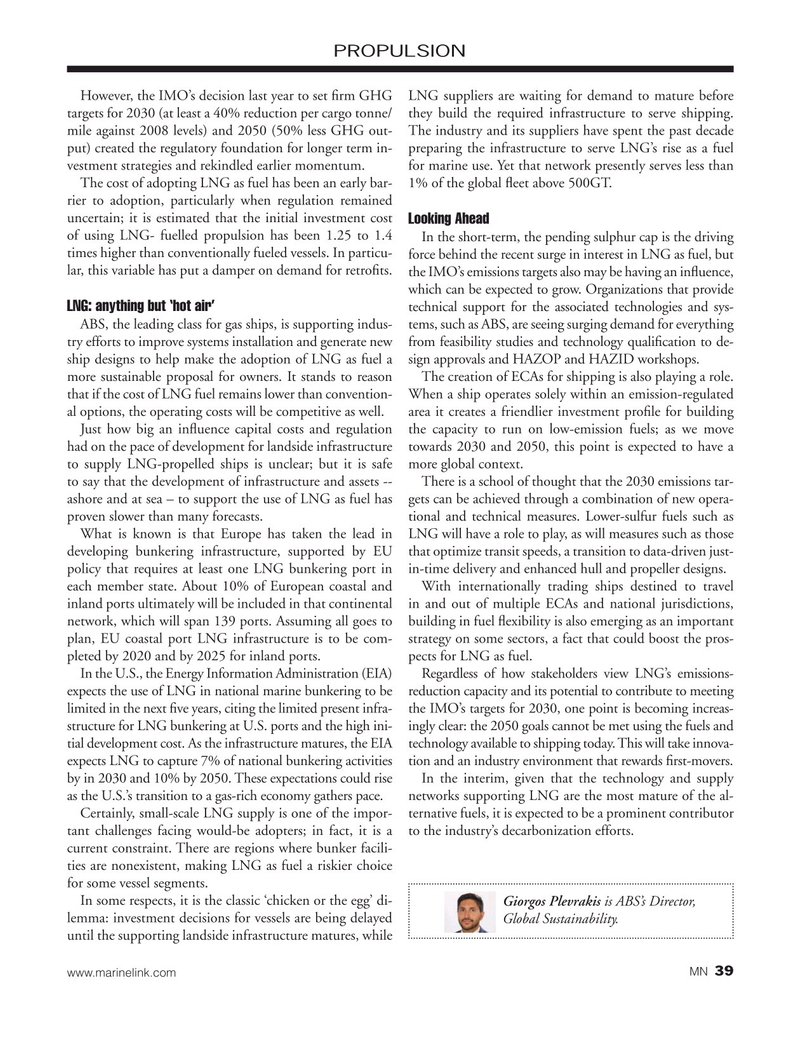
Page 39: of Marine News Magazine (September 2019)
Vessel Conversion and Repair
Read this page in Pdf, Flash or Html5 edition of September 2019 Marine News Magazine
PROPULSION
However, the IMO’s decision last year to set ? rm GHG LNG suppliers are waiting for demand to mature before targets for 2030 (at least a 40% reduction per cargo tonne/ they build the required infrastructure to serve shipping. mile against 2008 levels) and 2050 (50% less GHG out- The industry and its suppliers have spent the past decade put) created the regulatory foundation for longer term in- preparing the infrastructure to serve LNG’s rise as a fuel vestment strategies and rekindled earlier momentum. for marine use. Yet that network presently serves less than
The cost of adopting LNG as fuel has been an early bar- 1% of the global ? eet above 500GT.
rier to adoption, particularly when regulation remained uncertain; it is estimated that the initial investment cost
Looking Ahead of using LNG- fuelled propulsion has been 1.25 to 1.4
In the short-term, the pending sulphur cap is the driving times higher than conventionally fueled vessels. In particu- force behind the recent surge in interest in LNG as fuel, but lar, this variable has put a damper on demand for retro? ts.
the IMO’s emissions targets also may be having an in? uence, which can be expected to grow. Organizations that provide
LNG: anything but ‘hot air’ technical support for the associated technologies and sys-
ABS, the leading class for gas ships, is supporting indus- tems, such as ABS, are seeing surging demand for everything try efforts to improve systems installation and generate new from feasibility studies and technology quali? cation to de- ship designs to help make the adoption of LNG as fuel a sign approvals and HAZOP and HAZID workshops. more sustainable proposal for owners. It stands to reason The creation of ECAs for shipping is also playing a role. that if the cost of LNG fuel remains lower than convention- When a ship operates solely within an emission-regulated al options, the operating costs will be competitive as well. area it creates a friendlier investment pro? le for building
Just how big an in? uence capital costs and regulation the capacity to run on low-emission fuels; as we move had on the pace of development for landside infrastructure towards 2030 and 2050, this point is expected to have a to supply LNG-propelled ships is unclear; but it is safe more global context. to say that the development of infrastructure and assets -- There is a school of thought that the 2030 emissions tar- ashore and at sea – to support the use of LNG as fuel has gets can be achieved through a combination of new opera- proven slower than many forecasts. tional and technical measures. Lower-sulfur fuels such as
What is known is that Europe has taken the lead in LNG will have a role to play, as will measures such as those developing bunkering infrastructure, supported by EU that optimize transit speeds, a transition to data-driven just- policy that requires at least one LNG bunkering port in in-time delivery and enhanced hull and propeller designs. each member state. About 10% of European coastal and With internationally trading ships destined to travel inland ports ultimately will be included in that continental in and out of multiple ECAs and national jurisdictions, network, which will span 139 ports. Assuming all goes to building in fuel ? exibility is also emerging as an important plan, EU coastal port LNG infrastructure is to be com- strategy on some sectors, a fact that could boost the pros- pleted by 2020 and by 2025 for inland ports. pects for LNG as fuel.
In the U.S., the Energy Information Administration (EIA) Regardless of how stakeholders view LNG’s emissions- expects the use of LNG in national marine bunkering to be reduction capacity and its potential to contribute to meeting limited in the next ? ve years, citing the limited present infra- the IMO’s targets for 2030, one point is becoming increas- structure for LNG bunkering at U.S. ports and the high ini- ingly clear: the 2050 goals cannot be met using the fuels and tial development cost. As the infrastructure matures, the EIA technology available to shipping today. This will take innova- expects LNG to capture 7% of national bunkering activities tion and an industry environment that rewards ? rst-movers.
by in 2030 and 10% by 2050. These expectations could rise In the interim, given that the technology and supply as the U.S.’s transition to a gas-rich economy gathers pace. networks supporting LNG are the most mature of the al-
Certainly, small-scale LNG supply is one of the impor- ternative fuels, it is expected to be a prominent contributor tant challenges facing would-be adopters; in fact, it is a to the industry’s decarbonization efforts.
current constraint. There are regions where bunker facili- ties are nonexistent, making LNG as fuel a riskier choice for some vessel segments.
In some respects, it is the classic ‘chicken or the egg’ di- Giorgos Plevrakis is ABS’s Director, lemma: investment decisions for vessels are being delayed Global Sustainability.
until the supporting landside infrastructure matures, while 39 www.marinelink.com MN
MN Sept19 Layout 32-49.indd 39 8/27/2019 12:30:01 PM

 38
38

 40
40
